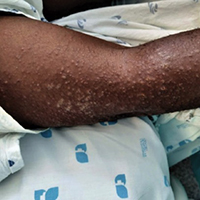DRESS syndrome (drug rash with eosinophilia and systemic symptoms): sometimes, not all signs are there

Published: 24 September 2021
Abstract Views: 1297
PDF: 523
HTML: 10
HTML: 10
Publisher's note
All claims expressed in this article are solely those of the authors and do not necessarily represent those of their affiliated organizations, or those of the publisher, the editors and the reviewers. Any product that may be evaluated in this article or claim that may be made by its manufacturer is not guaranteed or endorsed by the publisher.
All claims expressed in this article are solely those of the authors and do not necessarily represent those of their affiliated organizations, or those of the publisher, the editors and the reviewers. Any product that may be evaluated in this article or claim that may be made by its manufacturer is not guaranteed or endorsed by the publisher.
Similar Articles
- Anna Castrovilli, Tommaso Mastrofilippo, Lucia Di Fino, Caterina Foti, Giuseppe Ingravallo, Antonio Perrone, Carlo Sabbà, Francesco Saverio Vella, A recurrent, fatal, DRESS syndrome, complicated by sepsis and severe systemic cytomegalovirus reactivation at relapse: a case report , Italian Journal of Medicine: Vol. 13 No. 1 (2019)
You may also start an advanced similarity search for this article.

 https://doi.org/10.4081/itjm.2021.1475
https://doi.org/10.4081/itjm.2021.1475




